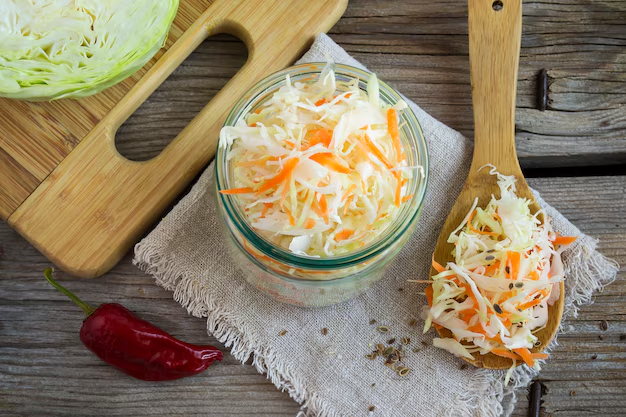Is Your Sauerkraut Still Good? Understanding Sauerkraut Storage in Your Refrigerator
Sauerkraut, that tangy, fermented cabbage dish loved by many, offers not only a unique flavor but also numerous health benefits. However, a common concern among sauerkraut enthusiasts is whether this fermented delight can spoil, even when stored in the refrigerator. Let's investigate the conditions under which sauerkraut can go bad and explore how to store it correctly to ensure it retains its peak quality.
What Happens During Sauerkraut Fermentation?
Before we delve into storage, it's important to understand the fermentation process that makes sauerkraut unique. Fermentation involves converting sugars in cabbage into lactic acid through bacterial cultures. This process not only enhances the flavor but also acts as a natural preservative, which is why sauerkraut can last a long time even without refrigeration.
Benefits of Fermentation
- Preservation: The lactic acid acts as a natural preservative, preventing the growth of harmful bacteria.
- Probiotics: Fermentation introduces beneficial bacteria that are good for gut health.
- Enhanced Flavor: The process increases the tanginess and depth of flavor over time.
Can Sauerkraut Go Bad in the Refrigerator?
Even though sauerkraut is robustly preserved, it isn't invincible. There are conditions under which sauerkraut can indeed spoil, even in the refrigerator.
Factors That Affect Sauerkraut Shelf Life
- Temperature Fluctuations: Frequent changes can disturb the lactic acid's preserving qualities.
- Exposure to Air: If not sealed properly, air exposure can lead to the growth of unwanted bacteria or mold.
- Contamination: Introducing foreign substances, through dirty utensils or hands, can introduce spoilage organisms.
- Age: Over extended periods, even fridge-stored sauerkraut can degrade in quality.
Signs Your Sauerkraut May Have Gone Bad
- Off-Smell: An unpleasant odor distinct from the usual tanginess can indicate spoilage.
- Discoloration: If you notice dark or slimy patches, this could be a sign of mold or bacterial growth.
- Texture Changes: Mushy or overly soft sauerkraut might be past its prime.
How to Store Sauerkraut Properly
Proper storage is key to maintaining the integrity and flavor of your sauerkraut for the longest time.
Tips for Optimal Storage
- Sealed Tight: Always ensure sauerkraut is stored in airtight containers to minimize air exposure.
- Consistent Refrigeration: Keep it consistently cold, ideally below 38°F (3°C).
- Use Clean Utensils: Always use clean utensils to prevent contamination.
Choosing the Right Container
Opt for glass jars or food-grade, BPA-free plastic containers with airtight lids. These materials do not react with the acidic nature of sauerkraut.
Extending the Life of Sauerkraut: Best Practices
Here’s a handy list of best practices for storing sauerkraut in the refrigerator:
- 🌡️ Maintain Cold Temperatures: Aim for a stable, cold environment.
- 🔒 Use Airtight Containers: Prevents bacteria and mold growth.
- 🍴 Avoid Cross-Contamination: Use clean utensils and refrain from dipping hands.
- 🧂 Consider Salt Level: Higher salinity can enhance preservation.
Homemade Sauerkraut vs. Store-Bought: Storage Differences
There are subtle differences in how you should store homemade versus store-bought sauerkraut.
Homemade Sauerkraut
Homemade batches might have variable acid levels, which can affect shelf life. Always check pH levels if possible, aiming for a level below 4.6 for safety. It’s often best to make smaller batches more frequently to ensure freshness.
Store-Bought Sauerkraut
Typically pasteurized and vacuum-sealed, store-bought sauerkraut may have a longer shelf life but might lack some probiotic benefits. Once opened, it should be treated like homemade sauerkraut in terms of storage.
The Role of Pasteurization and Preservatives in Store-Bought Sauerkraut
Understanding the effects of pasteurization and preservatives can help in anticipating how long it will keep after opening.
- Pasteurization: This heat process destroys bacteria, extending shelf life but at the cost of beneficial probiotics.
- Preservatives: Synthetic preservatives can enhance longevity but are not a substitute for proper storage.
Maximizing Flavor: How Long Should Sauerkraut Ferment?
For the best flavor, fermentation time is crucial. Typically, sauerkraut is left to ferment for 3-4 weeks. During this time, it's important to keep the fermentation vessel at a consistent room temperature, around 65-72°F (18-22°C), before transferring to the refrigerator.
Enhancing Taste
- 🧂 Experiment with Spices: Add caraway seeds or juniper berries for a unique twist.
- 🥕 Mix in Other Vegetables: Carrots and onions add complexity to the flavor profile.
Creative Uses for Sauerkraut Before It Spoils
If you notice your sauerkraut nearing the end of its shelf life, here are some innovative ways to use it up:
- 🥪 Classic Reuben Sandwiches: Sauerkraut pairs perfectly with corned beef and Swiss cheese.
- 🍲 Sauerkraut Soup: Add into stews for a tangy kick.
- 🌭 Gourmet Hot Dogs: Top your hot dogs or sausages with sauerkraut for added zest.
Final Thoughts
While sauerkraut is well-preserved by nature, proper handling and storage in the refrigerator can significantly impact its longevity. Always be mindful of temperature, sealing, and contamination risks to enjoy the full array of benefits sauerkraut offers. By following these guidelines, you can savor this delicious, healthful condiment without worry, knowing it’s in good condition as part of your culinary repertoire. Whether homemade or store-bought, when cared for correctly, sauerkraut remains a timeless addition to your fridge, offering both taste and nourishment.
